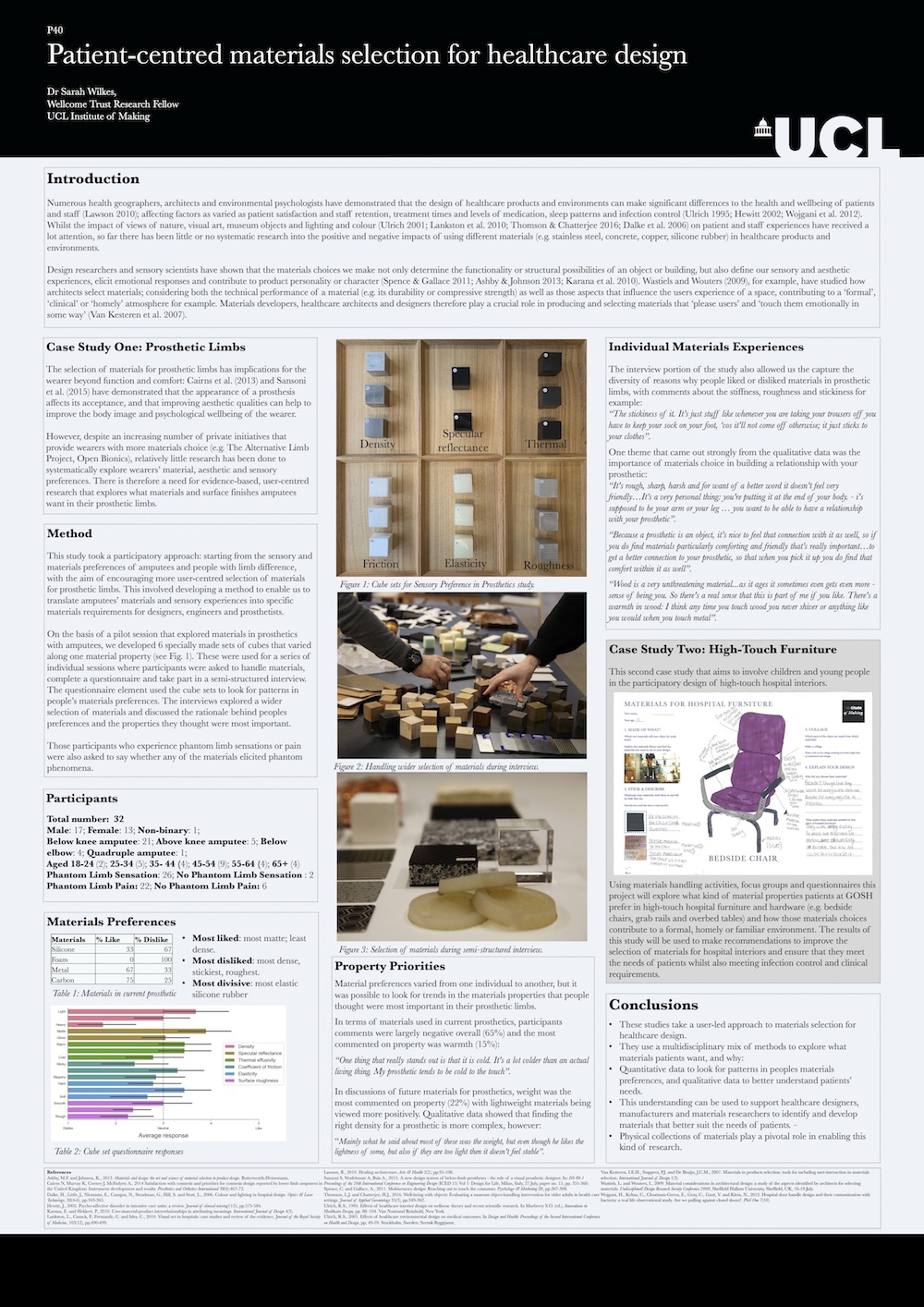Healthcare / Interior design
European Healthcare Design 2019
Patient-centred materials selection for healthcare design
By Dr Sarah Wilkes | 12 Jun 2019 | 0
This poster will present two participatory studies that explore the materials and sensory preference of users high-touch hospital furniture and prosthetic limbs.
Abstract
This poster will present the findings from an ongoing Wellcome Trust funded research project that aims to encourage patient-centred materials selection for healthcare applications, with one case study exploring material and sensory preference in prosthetic limbs, and another exploring materials selection for high-touch furniture in a paediatric hospital. It will also examine the role that materials library collections play in enabling this kind of participatory and interdisciplinary research around materials selection for healthcare.
Numerous health geographers, architects and environmental psychologists have demonstrated that the design of hospital environments can make significant differences to the health and wellbeing of patients and staff, affecting factors as varied as patient satisfaction and staff retention, treatment times and levels of medication, sleep patterns and infection control. While the impact of views of nature, visual art, museum objects, and lighting and colour on patient and staff experiences has received a lot of attention, so far there has been little or no systematic research into the positive and negative impacts of using different materials (eg, stainless steel, concrete, copper, silicone rubber) in the healthcare environment.
Design researchers and sensory scientists have shown that the materials choices we make not only determine the functionality or structural possibilities of an object or building but also define our sensory and aesthetic experiences, elicit emotional responses, and contribute to product personality or character. Wastiels and Wouters, for example, have studied how architects select materials, considering both the technical performance of a material (eg, its durability or compressive strength) and those aspects that influence the users’ experience of a space, contributing to a ‘formal’, ‘clinical’ or ‘homely’ atmosphere, for example. Materials developers, healthcare architects and designers play a crucial role in producing and selecting materials that ‘please users’ and ‘touch them emotionally in some way’, according to Van Kesteren et al (2007).
Equally, the selection of materials for prosthetic limbs has implications for the wearer beyond function and comfort: Cairns et al (2013) and Sansoni et al (2015) have demonstrated that the appearance of a prosthesis affects its acceptance, and that improving aesthetic qualities can help improve the body image and psychological wellbeing of the wearer.
Despite an increasing number of private initiatives that provide wearers with more materials choice (eg, the Alternative Limb Project, Open Bionics), relatively little research has been done to systematically explore wearers’ material, aesthetic and sensory preferences. There is therefore a need for evidence-based, user-centred research that explores what materials and surface finishes patients want in different healthcare products and environments.
This poster will present two participatory studies that explore the materials and sensory preference of users high-touch hospital furniture and prosthetic limbs. In particular, it will discuss the methods used to explore patients’ material and sensory preferences, examining the pivotal role of materials library collections in enabling this kind of research. It will discuss the development of specially made sets of object to represent a range of sensory and aesthetic properties (eg, hard-soft, rough-smooth, sticky-slippery) for use in object-handling tasks, combined with questionnaires, focus groups and semi-structured interviews.
This poster will also share the preliminary findings of the two case studies, examining how specific material properties and haptic experiences contribute to the atmosphere of healthcare interiors and acceptance of a prosthesis. It will also explore how material experiences vary from one user group to another. Finally, this poster will discuss the potential for these studies to encourage the development and selection of materials for healthcare applications that better meet the needs of patients and healthcare workers.
Organisations involved


